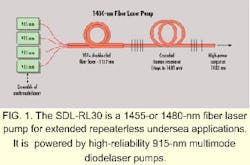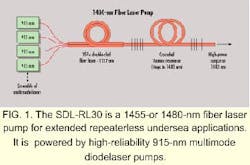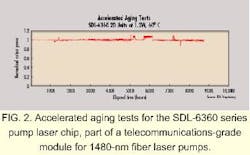Raman fiber lasers enable advances in repeaterless submarine networks
As network capacity requirements increase, the use and importance of fiber-optic submarine networks have also grown. Today's long-haul submarine networks transmit data at rates up to 10 Gbits/sec using wavelength-division-multiplexing technology. Overall system distances are typically thousands of kilometers, spanning most of the world's oceans.
In recent years, submarine systems also have become an accepted, economical solution for shorter transmission distances. These applications include
* linking terrestrial networks to islands
* island-to-island links
* short-distance submarine links along coastlines, called "festooned" or "coastal stitching" systems.
These shorter links are very economical because they avoid the use of costly submerged repeaters, which employ electronics and active optical components. In addition, they can be very cost-effective for these applications when compared to other transmission methods like satellite or microwave links.
Until recently, this approach was not usable for links greater than 300 km. But recent advances in fiber-optic technology have allowed the system operator to use the repeaterless approach for distances up to 450 km. It's estimated that 25% to 30% of all future repeaterless links will require distances longer than 300 km.
Traditionally, fiber-optic submarine networks have used architectures that consist of land-based terminal equipment at each end with submerged cable and a series of repeaters to regenerate signals, typically every 100 km. Repeaters are vital to a network's ability to transmit data over very long distances at low bit-error rates. However, optical amplifiers are increasingly used in place of repeaters. The amplifiers allow for a simpler design since, unlike repeaters, they do not contain significant amounts of active high-speed electronics. They can also be used in conjunction with repeaters to address attenuation problems.
The cable, repeaters, and amplifiers are submerged to a depth of thousands of meters, making any repair very expensive. Because of this, submarine system reliability requirements are much more stringent than those of terrestrial systems; the overall cable assemblies are typically designed for a 25-year service life.
While erbium-doped fiber amplifiers (EDFAs) at either the transmit or receive terminal site are used today to increase transmission distance, two other novel approaches are now available to increase the range of repeaterless technology:
* Pre-amplification using Raman techniques: In this approach, signal amplification is provided by using the trans-mission fiber to provide Raman gain. The Raman shift of silica fiber is about 13 THz above the pump wavelength, which corresponds to approximately 60 to 100 nm, depending on the pump wavelength. One very important benefit of Raman amplification is that it can be used over a wide range of wavelengths, rather than within a fixed wavelength region as with erbium-doped fiber technology. For transmission in the 1550-nm range, Raman amplification occurs when the transmission fiber is pumped with very high optical power at approximately 1455 nm. Therefore, by using a high-powered pump source at the receive terminal (in excess of 1W), the transmission fiber itself will provide gain in the 1550-nm window. Additional power budget improvement of up to 8 to 10 dB, equivalent to approximately 50 km extra distance, can be realized. This technique is referred to as "distributed Raman amplification" due to the fact that unlike a conventional EDFA, where amplification occurs in a single discrete amplifier module, the gain is spread out, or dis-tributed, over a significant fraction of the transmission wavelength. Repeaterless systems are one of the first practical applications of Raman amplification in active telecommunications systems.
* Remote pumping of submerged erbium-doped fiber blocks: While EDFAs can be integrated within the transmission cable instead of a repeater, a full EDFA still requires electronics and active fiber-optic components such as pump lasers. An alternative approach is to submerge only the erbium-doped fiber, without the electronics. These "passive" amplifiers can then be remotely pumped from either the transmit or receive terminal using a very high powered 1480-nm pump source. This approach potentially offers longer reach than the Raman technique, but requires a more complicated cable design because the passive amplifier blocks need to be embedded into the submerged cable. For this method, an additional fiber is also required to carry the pump output to the amplifier block.A critical technology for both of these approaches is the availability of a very high-power pump laser source. Discrete pump laser modules today are only capable of supplying hundreds of milliwatts into fiber. Telecommunications-grade frequency multiplexed singlemode pumps, using multiple pump modules, offer fiber coupled power up to 500 mW. However, this output is insufficient for the needs of longer-range repeaterless applications. For technical and economic feasibility, a source with output power greater than 1W is required.
Recently developed Raman fiber lasers, however, do deliver the required power at the necessary wavelengths. For example, one commercially available telecommunications-grade 1.5W pump source is available at either the 1455-nm wavelength for Raman pumping or at 1480 nm for remote pumping of submerged glass blocks.
The Raman fiber laser block of this laser contains several key elements to achieve the high output power required for these two applications (see Fig. 1). Naturally, the multimode diode-laser pump sources, which pump the fiber laser, are one of these key elements. Each diode operates at a wavelength of approximately 920 nm and has an output power of about 1W. Use of multiple diode pumps is an important facet of the design, since this allows for redundancy to meet the possibility of "soft fail" (non-catastrophic failures) within the unit.Even though reliability requirements for terminal equipment are less severe than for submerged equipment, it is extremely important that the laser sources meet telecommunications reliability standards. The accelerated aging test results for the chip of one such laser source are shown in Fig. 2.
Estimated FIT rates for the multimode laser-diode chip are 1500 FIT at P out of 1W at 25iC and 2000 FIT at P out of 1.2W at 25iC. Laser failures can typically be grouped into two broad categories: gradual degradation (also called wearout) or sudden random catastrophic failure. For high-powered pump lasers in the 920-nm range, the sudden cata strophic failure mechanism is the dominant failure mode.
Packaging of the laser module must also meet telecommunications standards. For example, the laser module referenced in Fig. 2 uses a standard 14-pin butterfly package. The packaged modules meet Bellcore standards for shock, vibration, temperature cycling, and thermal shock and have undergone 5000 hours of accelerated aging and 2000 hours of high-temperature storage as required by Bellcore TR-TWT-000468.
In addition to the laser modules, other elements play important roles in the performance of the pump laser source. For example, the control electronics provide the interface to the user's system and include laser-diode drivers for pump sources. The individual outputs from the broad area laser-diode modules are fed into a multimode combiner, which merges the light into a single multimode fiber for pumping the fiber laser. The diode lasers pump an ytterbium-doped double-clad fiber laser that delivers high optical power into a singlemode fiber at approximately 1100 nm. The output of the fiber laser is fed into a cascaded Raman resonator cavity that employs a low-loss fiber Bragg grating. The resonator and gratings perform successive Raman shifts of the output wavelength of the fiber laser. Depending on the desired output wavelength, the Raman fiber laser can be designed to operate at 1455 nm for Raman applications or at 1480 nm for remote pumping applications.
Typically, such a device is run at output power of 1.5W, but can be scaled to lower power to enable better overall system reliability. For example, when the unit is operated at 1W output, the pumps are driven at lower power levels, which increases their lifetime significantly. The Raman laser source also should provide excellent power-conversion efficiencies, typically 45% from the 1110-nm to the 1455/1480-nm output bands and approximately 20% from the 920-nm output bands of the pump lasers.
Submarine system operators have traditionally focused on the very long-reach transoceanic link market. Repeaterless systems are an increasingly popular approach to link geographic areas over shorter distances, such as between islands. Repeaterless systems can also be used along densely populated coastlines, creating festoons of links as an economical alternative to landlines or microwave systems. The availability of high-power laser sources allows the operator to extend the reach of repeaterless systems beyond what was previously possible. The availability of this technology has also led to one of the first practical applications of Raman amplification in active telecommunications systems.
Michael Trapp is marketing director, amplifier products, in the Communications Business Unit of SDL Inc. (San Jose, CA).


